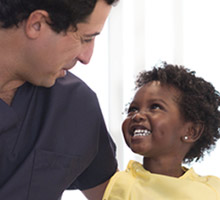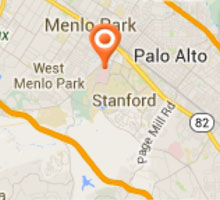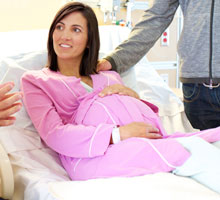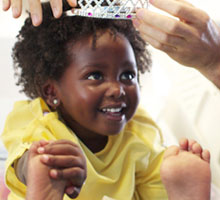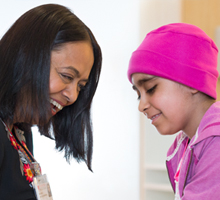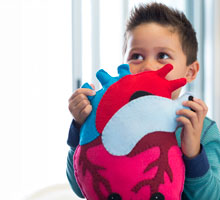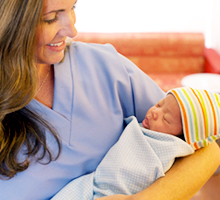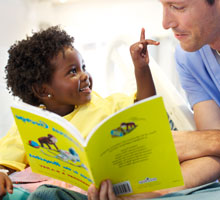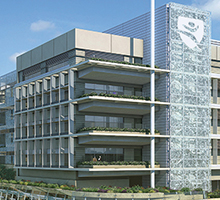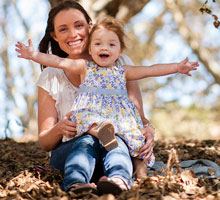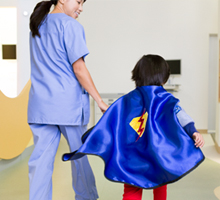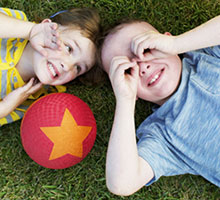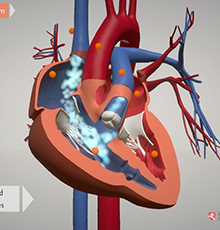What Cardiothoracic Surgery at the Children’s Heart Center Is Known for
Unifocalization: Repairing a Fourfold Defect All at Once
A small number of newborns suffer from a complex and potentially fatal congenital defect known as tetralogy of Fallot with pulmonary atresia and major aorto-pulmonary collaterals. In infants with this defect, the blood vessels that should connect the heart to the lungs instead connect the lungs to the aorta, and the heart itself has a hole in the wall separating its lower chambers (ventricles). Use our interactive 3-D animation to learn more about the heart and unifocalization.
In the past, surgeons could repair this complex and life-threatening defect only with several separate surgeries, each of which required the chest to be opened and the heart stopped. Unifocalization - developed and pioneered by Children’s Heart Center Director Frank L. Hanley, M.D. - repairs the complete defect with only one surgery, in the majority of patients.
In unifocalization, the misdirected blood vessels are rerouted into a single vessel (or into the pulmonary artery if it is present), which is then attached to the right ventricle of the heart through a conduit called a homograft. This restores normal circulation from lungs to heart. Next, the hole in the ventricle wall is repaired.
Because unifocalization is complex, the procedure takes six to 10 hours, and is followed by hospitalization of up to 14 days.
The benefits of unifocalization to the patient are significant. The procedure decreases overall hospital time for the child, and it reduces the number of major surgeries, anesthesias, and incisions, sparing the child additional pain and trauma. In addition, this procedure makes it more likely that the heart can be repaired before the child’s condition worsens and makes surgery either more difficult or, worst of all, impossible.
Complex Repairs in Premature and Very Small Infants
Premature newborns with both congenital heart disease and very low (less than 1,500 grams, or 3 pounds 4 ounces) or extremely low birth weight (less than 1,000 grams, or 2 pounds 3 ounces) pose a particularly difficult challenge because of their small size and immaturity. Conventional wisdom holds that it is better to wait for the child to develop further before undertaking heart repair. However, waiting entails serious risks, because the heart defect leaves the child highly vulnerable to potentially fatal complications such as infection or lung disease.
Since fixing the defect as soon as possible gives the infant the best chance of living normally, the Children’s Heart Center has developed techniques that allow congenital heart surgery even in extraordinarily small newborns, including successful repair in the smallest, youngest infant known. As a result of this experience, the Children’s Heart Center is among the world leaders in this demanding specialty.
Heart Transplant
The Children’s Heart Center is one of the leading heart and heart-lung transplantation programs in the world and the only program in Northern California. To learn more about this treatment option, visit the heart transplant program's page and our Health Library.
Innovative Research Programs
The Children’s Heart Center is actively involved in exploring new approaches to the surgical repair of pediatric heart disease and developing evidence-based guidelines for clinical care. Current efforts focus on three areas:
- Repairing the unborn heart. A Children’s Heart Center research team is investigating ways of diagnosing heart rhythm problems while the fetus is still in the womb and performing corrective surgeries before birth. The Center is the world’s leading site for research in this area, spearheaded by Frank Hanley, MD.
- Seeing the heart in depth. The Children’s Heart Center also leads the nation in the use of electronic beam three-dimensional CT (computerized tomography) scanners, which provide highly accurate images of the heart and major vessels. These images give surgeons a detailed view of the patient’s condition and allow thorough planning of the procedure in advance.
- Robots and surgery at a distance. Using a voice-activated robot equipped with a tiny fiber-optic camera that projects images on a computer screen, the surgeon can go directly to the problem area without stretching heart tissues or distorting delicate structures. Since robot surgery uses only three small incisions — one for the camera and two for surgical instruments — this approach minimizes pain and trauma. It also raises the possibility of surgery at a distance, in which a physician on a computer at the Children’s Heart Center performs a procedure on a child miles away in an operating room in his or her home community.




